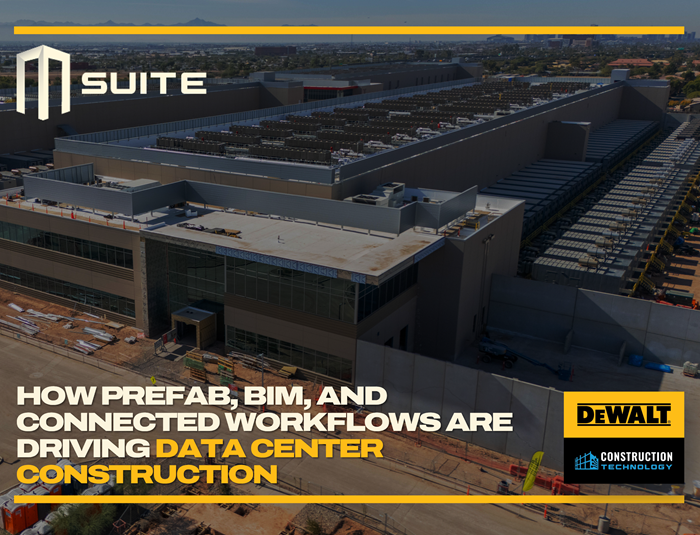In today’s digital economy, data is like new infrastructure. The race is on to build data centers that are faster, smarter, and more reliable. Traditional construction methods are struggling to meet the demands of this high-stakes industry.
Enter a new era of prefabrication, Building Information Modeling (BIM), and connected workflows. These approaches are transforming the design, fabrication, and delivery of mission-critical facilities.
We look at how digital fabrication and modular construction are changing data center building. We also see how DEWALT Construction Technology’s MSUITE helps this change during the BIM-to-FAB-to-Field process.
Why Data Center Construction Is a Different Challenge
Data centers are among the most complex and time-sensitive projects in the construction industry. They require:
- Extreme precision and tolerances — cooling, power, and airflow systems demand millimeter-level accuracy.
- Aggressive schedules — fast-tracked timelines leave no room for rework or delays.
- Complex coordination — mechanical, electrical, plumbing (MEP), structural, and IT teams must align perfectly.
- High capital risk — even minor errors can cause massive cost overruns and schedule setbacks.
- Scalability and adaptability — capacity must often expand rapidly after commissioning.
Because of these pressures, owners and contractors are using offsite fabrication, modularization, and digital construction. These methods help increase certainty and speed.
Prefabrication: The Game-Changer for Data Center Construction
Prefabrication is revolutionizing the construction of data centers. Instead of depending only on field labor, many companies manufacture parts of systems offsite in controlled environments. These parts include racks, pipe spools, cable trays, and hangers.
Key Benefits
- Time compression/speed to market – Prefab allows parallel workstreams—while the site is being prepared, modules are being built offsite. Research shows projects can cut on-site time by up to 30–40%. Source. Additional reference.
- Quality and consistency – Controlled fabrication environments produce tighter tolerances, more repeatable quality, and fewer field errors.
- Cost control and waste reduction – Material waste and rework drop significantly when assemblies are fabricated digitally and built in a single instance.
- Scalability and flexibility – Prefabricated modules can be easily “plugged in” to accommodate future capacity.
- Safer jobsites and simpler logistics – Fewer trades on-site means less congestion and fewer safety risks.
BIM: The Digital Backbone of Modern Data Centers
Prefabrication succeeds only when powered by BIM—the digital foundation that connects design to fabrication.
How BIM Enables Efficiency
- Early clash detection and coordination – BIM identifies system conflicts across MEP and structural trades before fabrication. Source
- Fabrication-ready modeling (LOD 400+) – Detailed 3D models generate spool drawings and assembly sheets directly from BIM. Source
- Integrated logistics and scheduling (5D BIM) – BIM connects geometry to time and cost, allowing precise delivery and installation sequencing.
- Digital twin for commissioning and O&M – BIM serves as the foundation for digital twins, streamlining operations and facilitating future retrofits. Source
In short, BIM connects every stakeholder through a single source of truth, improving quality, predictability, and collaboration.
Connected Workflows: From Design → Fabrication → Field
The most advanced data center builders are eliminating silos.
- Connected workflows link teams, models, and production data into a seamless pipeline.
- Design collaboration in a shared BIM environment – All trades work from the same coordinated model.
- Automated layout and hanger generation – Advanced tools auto-populate supports, routing, and assemblies (MSUITE Hangers).
- Digital shop packages and spooling – Fabrication sheets and metadata flow directly from BIM to the shop floor (MSUITE Fab).
- Field feedback and progress tracking – Installation teams capture real-time status updates, deviations, and as-built conditions.
- Analytics dashboards – Leaders gain visibility into performance, bottlenecks, and productivity (MSUITE Analytics).
When connected properly, these workflows deliver predictable, repeatable results that reduce time and increase profitability.
The Measurable Impact
Benefit Impact : Metric
- Schedule compression: 20–40% shorter on-site duration
- Reduced rework: Fewer change orders, and coordination errors
- Cost predictability: Better budgeting, and project control
- Lower waste: 10–20% less material waste
- Scalability: Modular “plug-and-play” capacity expansion
- Operational readiness: Digital twin handoff for ongoing maintenance
How MSUITE Powers the Future of Data Center Construction
MSUITE delivers the digital infrastructure behind high-performance data centers.
Key capabilities include:
- Automated hanger generation – eliminate manual layout time.
- Cloud spooling and shop package creation – seamless BIM-to-FAB workflows.
- Real-time shop and field tracking – visibility across production and installation.
- Closed feedback loops – feed as-built changes back into design.
- Actionable analytics – track KPIs, identify bottlenecks, and measure throughput.
MSUITE helps contractors build data centers faster. It connects BIM, fabrication, and field teams. This leads to better quality and more profit.
Emerging Trends to Watch
- AI-driven design optimization — generative BIM for layouts and system routing.
- Robotics in construction — automated installations guided by BIM models.
- Digital twin integration — real-time IoT data improving operations.
- Blockchain for QA and traceability — secure verification of build changes.
- Sustainability tracking — BIM enabling embodied carbon and energy modeling.
The future of data center construction is digital, automated, and data-driven—and it’s already here.
Getting Started: A Roadmap for Contractors
- Align early. Bring designers, fabricators, and field teams together before design freeze.
- Adopt BIM-to-FAB standards. Move from PDFs to fabrication-ready models.
- Pilot prefab assemblies. Start with one trade or module before scaling.
- Implement closed feedback loops. Use digital tools to sync progress and QA data.
- Measure and refine. Track productivity, waste, and cycle times to optimize efficiency.
Conclusion
Data center construction is evolving at a faster pace than ever. Contractors who embrace prefabrication, BIM, and connected workflows are achieving unmatched levels of efficiency, accuracy, and scalability.
With DEWALT Construction Technology and MSUITE, every stage becomes part of a connected system. This includes making models and installing them in the field. This team designed this system for the next generation of digital infrastructure.









